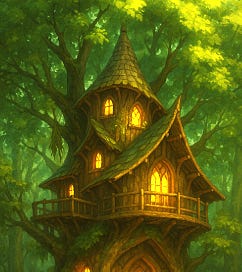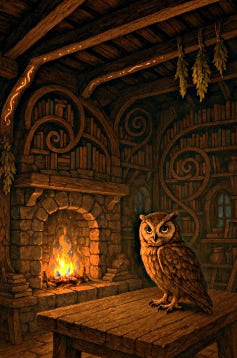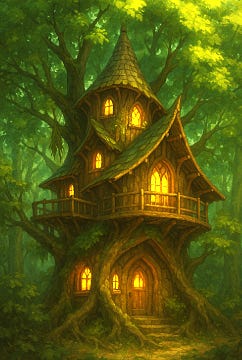More Than Shelter: An Anthropological Look at Fantasy Housing
A deep dive into what fantasy homes tell us about identity, memory, and belonging
Welcome to the third installment of Anthropological Worldbuilding 101
No matter where people live, their environment dictates their housing.
If they’re smart about it, anyway.
Cold climates demand thick walls and low ceilings to trap heat. A central hearth becomes the heart of the home—more than warmth, it’s survival, community, and cooking all in one. Windows must be considered carefully. Too few, and you’re living in a cave. Too many, and the wind slices through like a knife. Those who dwell in the chill want every scrap of sunlight they can get—but too much glass, and you may as well invite the frost in for tea.
Flood-prone areas have no patience for foolishness. Build low, and the river will claim your rugs. That’s why houses rise on stilts—tall, skeletal legs that keep living quarters high and dry. In some cultures, homes don’t just perch—they float. Bobbing gently on the tides, lashed to docks or anchored with charmstones, they drift with the seasons and the stories.
In the deep green hush of forests, homes might wind around tree trunks or nestle in canopies like woven cradles. Ladders creak, platforms sway, and walkways link families like root systems in reverse. These homes breathe with the forest, open to breezes and leaf-filtered light. In some places, the trees themselves are coaxed to grow into houses, their branches shaped over decades into shelter.
Desert dwellers? They burrow. They dig deep into cool earth or stack thick adobe bricks that soak up the sun’s heat during the day and release it at night. Courtyards bloom in the center—oases of shade and stillness. Stone floors and high ceilings make every breeze a blessing. Roofs become bedrooms, cool and open beneath the stars.
The most successful and comfortable homes take local environment into consideration.
This is no less true in fantasy fiction.
In fact, fantasy gives us the freedom to push those principles even further. What if homes are shaped by magic as much as mud? What if your roof needs to withstand acid rain from the dragon nesting up the mountain? What if your house floats not on water, but on wind currents—anchored only by a ritual stone and the strength of your family’s name?
The choices people make when building shelter speak volumes about what they value: safety, comfort, status, tradition, innovation.
What Homes Reveal About Culture
It’s tempting to think of houses as just “where people live.” But they’re more than shelter. A home tells us what a society protects, what it celebrates, and what it’s quietly trying to control.
Let’s start with something simple: privacy.
In some cultures, privacy is a luxury. Communal longhouses, for instance, don’t just reflect environmental efficiency—they echo social cohesion. If you grow up hearing every cough, argument, and midnight tryst in your household, you learn early that life is lived together. But in cultures where solitude is prized, you might find homes carved with individual cells, rooms within rooms, and thresholds that mark sacred personal space.
Now add gender into the mix.
Do all genders live under the same roof? Are there separate spaces for rituals, menstruation, childbirth, or manhood trials? In some societies, a man might enter the women’s cooking space only during mourning. In others, only women may pass through the inner door of a temple-home. In fantasy, we can take this further. What if a home itself refuses entry to anyone not aligned with its original gender codes? What if walls “listen” and judge those who defy their roles?
Then there's status.
Where you live and how, says a lot about your place in the pecking order of society. In caste-based or feudal systems, the layout of a town is a map of power. The wealthy build upward: towers, balconies, roof gardens that touch the clouds. The poor build outward or downward, clinging to alleyways, the outer rim, or underground tunnels. Even materials send signals. Do only the elite have stone or glass, while others are stuck with thatch and mud? What does it mean when someone chooses a humble home despite having wealth? What does that say about them?
And let’s not forget kinship structure.
Do homes hold a nuclear family, a clan, or a fluid blend of both? In matrilineal cultures, the mother's family may all live under one roof, with husbands and lovers visiting but rarely staying. In cultures that revere ancestors, shrines, grave-reliefs, or even embedded bones become part of the home’s foundation—literally living with the dead.
Or consider homes that move: tents, wagons, mobile towers, or floating islands. Mobility isn’t just a lifestyle choice—it’s often rooted in spiritual worldview or political history. Maybe a group was displaced generations ago and vowed never to settle. Maybe their gods only speak when they move with the seasons.
Homes are maps. Not of streets, but of values.
They show us who holds power. Who is hidden. Who is honored. They reveal which direction the soul sleeps in, which door death enters, what kind of noise is acceptable, and what kind of silence is feared.
Magic IN the Home
In fantasy, a house doesn’t have to be passive. It can breathe, remember, protect, or judge. Just as real-world homes reflect culture, fantasy homes reflect the very soul of a magical society.
Some homes are more than shelter—they’re characters. We’re talking “smart homes” fueled by magic.
A door that refuses to open unless it’s been greeted. A cottage that shifts its windows depending on the weather—or its mood. A house that chooses its occupants, bonding with them through blood, oath, or intent.
These sentient homes raise questions of consent, inheritance, and agency. Who gets to live in a place that can exile you with a creak and a slam? And what does it mean when your shelter has opinions?
In many cultures, building a home is a spiritual act. In fantasy, it can be a magical one.
Maybe foundations must be laid during an eclipse. Perhaps the wood must come from trees that whispered to the builder. The angle of the hearth might direct the flow of magic, or the roof peak might point to a constellation tied to the family’s luck. Rooms could be aligned with the elements, the seasons, or virtues. Leave out a key ritual—fail to bury the spell-stone under the threshold—and your home becomes a magnet for misfortune.
In magical societies, even mud can hold secrets.
Bricks molded from clay mixed with phoenix ash retain warmth in winter and clarity of thought in times of grief. Thatched roofs woven from silversedge keep out both rain and lies. Floorboards in noble homes might be inlaid with memory runes to recall family histories—useful for guests and spies. Imagine the potential stories there!
The threshold has always been sacred. In fantasy, it’s often literal protection.
Some homes wear enchantments like armor: a silence spell over the nursery, a truth ward in the dining room, anti-scrying curtains that flutter only when lies are spoken nearby. These enchantments might be tied to emotions, ancestry, or magical currents in the land. Lose the land’s favor, and your walls may crumble no matter how well-built they are!
There is so much more room for possibility in fantasy fiction. A witch’s home might attract wandering spirits. A lighthouse that turns time backward at midnight, a sunken ruin that only rises when a name is spoken, a library-house whose shelves rearrange based on the reader’s mood. What does that lighthouse tell us about its builder or occupant? What does the sentient library tell us about the community that surrounds it?
Fantasy homes deepen the stakes of hospitality, exile, inheritance, and memory. They reinforce the idea that a house isn’t just a backdrop—it’s a container for power, belief, and belonging.
Every floorboard, every thatched roof, every creaking stairwell holds meaning. In fantasy, the humble act of building shelter becomes an act of world-shaping—sometimes even world-saving. Whether carved from stone, whispered into being, or stitched together from leaves, grass, and memory, a home tells us what a people fear, what they hope for, and what they refuse to forget. The walls remember. The hearth speaks. And the way people build is the way they believe. So when you're building your world, don’t just draw the map—walk through the front door. Ask what the walls are made of. Ask what’s hidden under the floorboards. Ask what story the house is telling... and who gets to hear it.
If you’ve enjoyed this essay, please help support An Enchanted Life either through a one-time donation or a paid subscription. Your contribution means that we can keep the lights on and feed the cat!
Did you see our first two installments in this series?
What Fantasy Gets Wrong About Culture & How To Get it Right
Worldbuilding Through the Womb: Rethinking Inheritance in Fantasy







This is a wonderfully written article that is a goldmine of ideas. Each installment keeps getting better. Thank you for taking the time to write this.